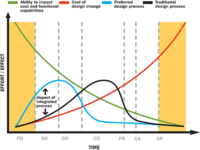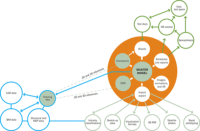The inefficiencies inherent in the process of design and construction are necessitating a shift to greater multidisciplinary collaboration and information sharing among project team members
This is an exciting time to practice architecture. Architects and engineers seem to be able to design and construct almost anything they can imagine, and the data they use enables these buildings to be well managed by their owners. Architects, consultants, and owners are also working together more closely than ever.
Integrated practice (IP) is the term that is being assigned to this collaborative process. IP is a meaningful response to the ongoing marketplace mandate for buildings that are faster to design and construct, at lower cost, as well as more sustainable and of higher quality than those built in the past. Building information modeling (BIM) is enabling— some say forcing—this information-sharing, integrated-practice culture to emerge.
BIM, of course, is the parametric object-based software that is used to create not only a three-dimensional model of a virtual building, but also drawings and rich databases of information that can include such things as budget estimates, construction schedules, quantities takeoffs, and fabrication details. Parametric modeling allows for substantial changes to be made quickly and for easy interference-checking to occur. These and other features are discussed in record’s April architectural technology article, “Transformative Tools Start to Take Hold.”
There is nothing new about architects, clients, and consultants collaborating. William Caudill, FAIA, of the firm Caudill Rowlett Scott, coined the term squatters in the 1950s to describe meetings between the architect, engineering consultants, owner, and users—on the owner’s home turf before design began—to program, clarify values, and brainstorm design ideas. William Lam, the renowned lighting designer, who often worked with Caudill, says, “Rapport and sensitivity among individuals is essential so that meaningful dialogue can continue. An individual has to care more about results than his or her ego.”
Firm cultureLam could just as well have been describing how firms today should approach integrated practice. Although consultants often met during squatters and then went their separate ways, BIM demands that project teams meet and exchange information frequently. The shakeout of what the building information model and its supporting technology means for teams engaging in integrated practice has begun and continues at a rapid pace. And there are a number of significant consequences that affect firm culture, standard contracts, liability insurance and risk management, compensation, and professional education. Those who think critically and innovatively about these new business practices will lead the way and prosper.
Perhaps the biggest cultural change is not learning how to use new tools and technology, but rather the attitude adjustment required to collaborate effectively with the entire team from the start. According to Volker Mueller, Assoc. AIA, design technology manager of NBBJ, this calls for “the alignment of project goals across the entire project team and a fundamental understanding that the project has to start coming together at kickoff rather than after procurement. Today’s increasingly complex projects require the input of a broad-based team.”
“Architects should concentrate on leadership rather than ownership; on design rather than avoiding risk,” says Scott Simpson, FAIA, senior principal, KlingStubbins. “The efforts of dozens of consultants need to be managed and coordinated, placing a premium on architects’ leadership skills.” With the right people on the team, the right tools, and a smart process, effective leadership will orchestrate the creation of great architecture. That point is succinctly underscored by Andy Anway of the Boston exhibition design firm Amaze Design. “The senior-level people must be committed to achieving a common outcome, with financial or other incentives to keep that singular mind-set in place. The success of a team-based process is a function of mutual cooperation and mutual benefit,” he says. Anway feels that, in this model, many architects will have to overcome a certain sense of loss about having total control over design.
It seems intuitive that not only will emerging architects have great design opportunities working in an IP model, but that they will have the opportunity to learn leadership skills. Diane J. Hoskins, AIA, the executive director of Gensler—where everyone in the 1,700-person firm is either involved in a project using BIM or learning how to use the technology—says, “With BIM, we no longer have an assembly-line process; this means our young staff need to understand the whole project so they can work effectively across plan, section, detail, and elevation. It is a steep learning curve in the first several years of one’s architectural maturation.”




Post a comment to this article
Report Abusive Comment